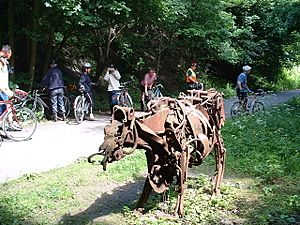Sea to Sea Cycle Route facts for kids
Quick facts for kids Sea to Sea Cycle Route (C2C) |
|
|---|---|
|
|
| Length | 202 km (126 mi)–222 km (138 mi) |
| Trailheads |
|
| Elevation | |
| Highest point | Black Hill (near Allenheads), 609 m (1,998 ft) |
| Waymark | |
The Coast to Coast or Sea to Sea Cycle Route (C2C) is a famous cycle route in England. It opened in 1994 and is about 140 miles (230 km) (225 km) long. This route is part of several National Cycle Routes, like 7, 14, 71, and 72.
The C2C starts on the west coast of Cumbria at either Whitehaven or Workington. It then crosses the beautiful Lake District and the Pennines mountains in northern England. The route uses a mix of paths, some on roads and some off-road. It finishes on the north-east coast in Tyne and Wear at Sunderland or Tynemouth.
Sustrans, a charity that promotes cycling, says the C2C is the UK's most popular challenge route. It's made for all types of cyclists, from families to experienced club riders. Even though it has some tough climbs, reaching over 609 m (1,998 ft) (2,000 feet) at its highest point, many people complete it. Between 12,800 and 15,000 cyclists ride the C2C every year!
History of the C2C Cycle Route
The C2C is part of the UK's National Cycle Network (NCN). It was created by Sustrans working with many groups. These included local councils, Groundwork West Cumbria, and the Lake District National Park.
The route first opened in 1994. It ran from Whitehaven on the west coast of Cumbria to Sunderland on the north-east coast. Later, a northern path was added. This path splits off from the main route near Consett and goes through Tyneside, ending at Tynemouth.
In 2005, another route called the Walney to Wear (W2W) was opened. This route is a bit longer and harder. It goes from Walney Island in south-west Cumbria to Sunderland.
Art Along the Route
As you cycle the C2C, you'll see some cool public artworks. These pieces of art were specially made for the route. For example, there's a sculpture called Terris Novalis by Tony Cragg in Consett.
You can also spot sheepfolds (small stone pens for sheep) made by Andy Goldsworthy in Cumbria. In the River Wear at Sunderland, there's a sculpture called Ambit by Alison Wilding. Near Annfield Plain, you might see The Old Transformers by David Kemp. Plus, there are four steel cows by Sally Matthews near Beamish Museum.
Exploring the C2C Route
The C2C has two places where you can start your adventure in Cumbria. You can begin at Whitehaven or Workington. From there, you'll cycle through the amazing views of the western and northern Lake District.
The Workington path goes through Cockermouth to Keswick. The Whitehaven path goes through Loweswater to Keswick. After Keswick, the route passes through Penrith and the Eden Valley. This area has green valleys and villages built with sandstone.
Then, the climb begins up to Hartside Pass and into the North Pennines. This area is often called the "roof of England" because it's so high up! The C2C then winds through old lead-mining villages like Garrigill and Nenthead. You'll also pass through Rookhope and into the Durham Dales.
After that, you cross Waskerley Moor and enter the old steel town of Consett. You'll ride over the impressive Hownes Gill Viaduct.
From Consett, it's an easier ride. You'll go through places like Leadgate, Annfield Plain, Stanley, and Beamish. This part of the route takes you through an area that was once a big industrial center. Finally, you reach the North Sea at Sunderland.
You also have choices for your journey. You can start at Workington and/or finish at Tynemouth. There's even a link route at Penrith to connect with the route from Glasgow to Carlisle.
The C2C route is made up of different types of paths:
- Main roads: These are mostly short parts through towns – about 4% of the route.
- Minor roads: These are quiet country roads – about 50% of the route.
- Cycle paths/off-road: These are paths like old railway lines – about 46% of the route.
Most cyclists ride the C2C from west to east. This is because the wind usually blows from the west, which helps push you along! Also, the hills are often easier to climb when going in this direction. It's a tradition to dip your back wheel in the Irish Sea at the start. Then, you dip your front wheel in the North Sea at the end to show you've completed the challenge!
Sometimes, parts of the route might be closed due to floods or forestry work. But don't worry, there are always signs for alternative paths.
Most people finish the C2C in 3 to 5 days. However, some very fast cyclists have completed it in a single day! The record is currently 7 hours, 53 minutes, and 3 seconds. The youngest person to do it in one day was Christian Webster-Reed, who was 15 years old.
The C2C connects to other parts of the National Cycle Network. This means you can use it as part of a longer cycle tour if you want to explore even more! You can find maps and guides for the C2C from Sustrans.


